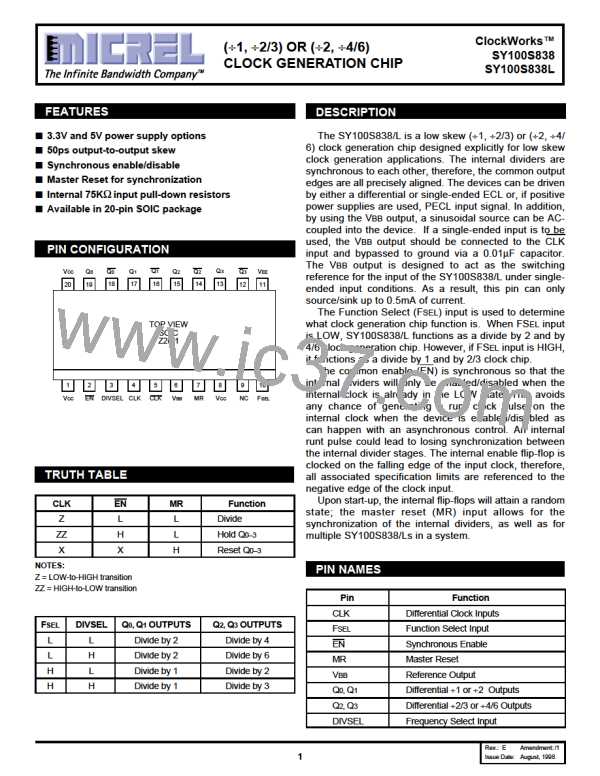ClockWorks™
SY100S838
SY100S838L
(÷1, ÷2/3) OR (÷2, ÷4/6)
CLOCK GENERATION CHIP
FEATURES
DESCRIPTION
ꢀ 3.3V and 5V power supply options
ꢀ 50ps output-to-output skew
The SY100S838/L is a low skew (÷1, ÷2/3) or (÷2, ÷4/
6) clock generation chip designed explicitly for low skew
clock generation applications. The internal dividers are
synchronous to each other, therefore, the common output
edges are all precisely aligned. The devices can be driven
by either a differential or single-ended ECL or, if positive
power supplies are used, PECL input signal. In addition,
by using the VBB output, a sinusoidal source can be AC-
coupled into the device. If a single-ended input is to be
used, the VBB output should be connected to the CLK
input and bypassed to ground via a 0.01µF capacitor.
The VBB output is designed to act as the switching
reference for the input of the SY100S838/L under single-
ended input conditions. As a result, this pin can only
source/sink up to 0.5mA of current.
ꢀ Synchronous enable/disable
ꢀ Master Reset for synchronization
ꢀ Internal 75KΩ input pull-down resistors
ꢀ Available in 20-pin SOIC package
PIN CONFIGURATION
Q
1
Q3
V
CC
Q
0
Q
0
Q
1
Q
2
Q
2
Q
3
VEE
18
17
16
15
14
13
20
19
12
11
The Function Select (FSEL) input is used to determine
what clock generation chip function is. When FSEL input
is LOW, SY100S838/L functions as a divide by 2 and by
4/6 clock generation chip. However, if FSEL input is HIGH,
it functions as a divide by 1 and by 2/3 clock chip.
The common enable (EN) is synchronous so that the
internal dividers will only be enabled/disabled when the
internal clock is already in the LOW state. This avoids
any chance of generating a runt clock pulse on the
internal clock when the device is enabled/disabled as
can happen with an asynchronous control. An internal
runt pulse could lead to losing synchronization between
the internal divider stages. The internal enable flip-flop is
clocked on the falling edge of the input clock, therefore,
all associated specification limits are referenced to the
negative edge of the clock input.
TOP VIEW
SOIC
Z20-1
1
2
3
4
5
6
7
8
9
10
V
CC
EN DIVSEL CLK CLK
V
BB
MR
V
CC
NC
FSEL
TRUTH TABLE
Upon start-up, the internal flip-flops will attain a random
state; the master reset (MR) input allows for the
synchronization of the internal dividers, as well as for
multiple SY100S838/Ls in a system.
CLK
Z
EN
L
MR
L
Function
Divide
ZZ
X
H
L
Hold Q0–3
X
H
Reset Q0–3
NOTES:
PIN NAMES
Z = LOW-to-HIGH transition
ZZ = HIGH-to-LOW transition
Pin
CLK
Function
Differential Clock Inputs
Function Select Input
Synchronous Enable
Master Reset
FSEL
L
DIVSEL
Q0, Q1 OUTPUTS
Divide by 2
Q2, Q3 OUTPUTS
Divide by 4
FSEL
EN
L
H
L
L
Divide by 2
Divide by 6
MR
H
Divide by 1
Divide by 2
VBB
Reference Output
H
H
Divide by 1
Divide by 3
Q0, Q1
Q2, Q3
DIVSEL
Differential ÷1 or ÷2 Outputs
Differential ÷2/3 or ÷4/6 Outputs
Frequency Select Input
Rev.: E
Amendment:/1
Issue Date: August, 1998
1

 MICREL [ MICREL SEMICONDUCTOR ]
MICREL [ MICREL SEMICONDUCTOR ]